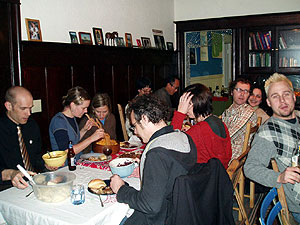I wonder if homes in the past fifty years or so have undergone a similar evolution in architecture-- or devolution, depending on your point of view-- as churches.
 Dining with FriendsDuring my former career as a Catholic priest, I taught a few Religious Studies classes at a small college. My favorite text in one class was a book by a Capuchin priest, Edward Foley, titled From Age to Age: How Christians Have Celebrated the Eucharist . Foley uses the history of church architecture, vessels, books, and music to tell the story of Christian worship.
Dining with FriendsDuring my former career as a Catholic priest, I taught a few Religious Studies classes at a small college. My favorite text in one class was a book by a Capuchin priest, Edward Foley, titled From Age to Age: How Christians Have Celebrated the Eucharist . Foley uses the history of church architecture, vessels, books, and music to tell the story of Christian worship.
In the book, Foley describes how the Christian church was once a home adapted for worship. In the 1920’s, archeologists uncovered the first known Christian church at the site of Dura Europos (in present day Syria), a Roman garrison town destroyed by the Persians in the 3rd century. It had a central courtyard where people could gather and a fountain where baptisms might have been performed. In the 4th Century, when Christianity became the de facto religion of the Roman Empire, worship began to take place in Roman meeting halls, where governors and other higher-ups would address the citizens of the town (this explains the origins of the term basilica, or "king’s house"). The meeting halls were larger and less intimate, but held more people.
Fast forward through the Middle Age monasteries to the great cathedrals of Europe. In these great cathedrals, the presider (the host of the sacred meal) had his back turned to the people most of the time during worship, and the average Christian would get nowhere near the communion meal of bread and the wine. People became even further separated from the true purpose of their worship, and came to church mostly to see the beautiful stained glass windows, to hear beautiful music, and to watch a colorful and dramatic spectacle.
When Europeans immigrated to America, they tended to bring their churches with them-- in miniature. An architect friend told me that the Basilica of the Sacred Heart at the University of Notre Dame, in the Prairie Gothic style, could fit inside the church of Notre Dame in Paris. Today, churches are a little more diverse, but most are still a far cry from the small adapted homes of the 3rd century where a few people gathered in an intimate setting to tell stories and break bread together.
